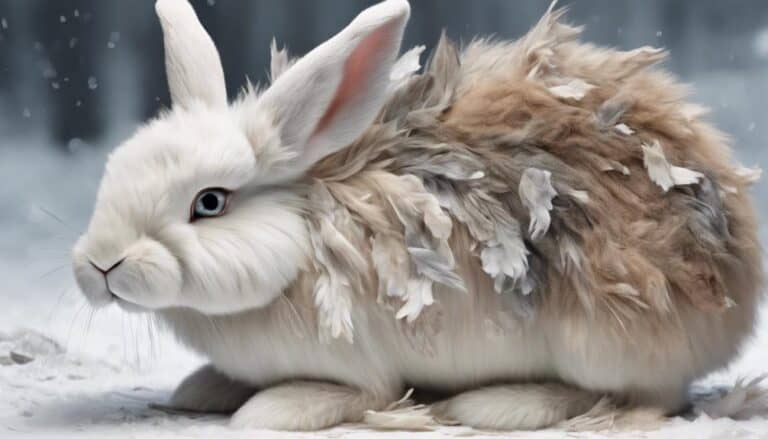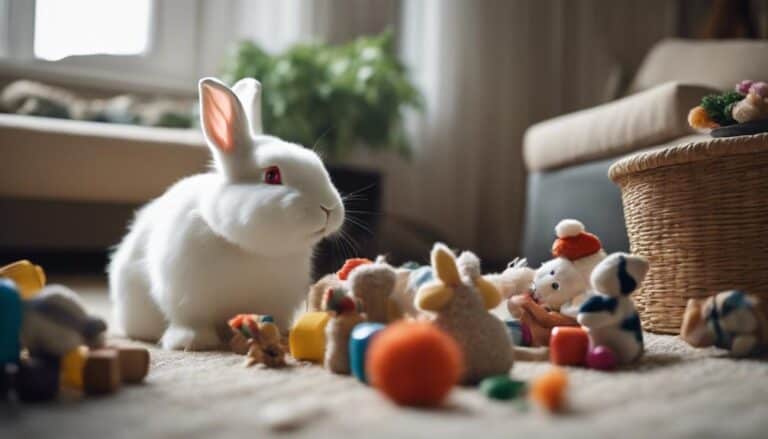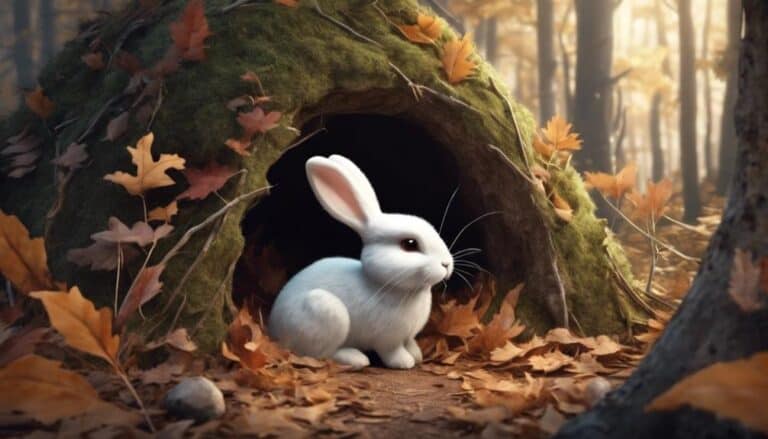When bunnies chow down on fibrous plants like grass and hay, their digestive system goes to work, especially the caecum. This special part breaks down tough plant stuff through hindgut fermentation. Why? So the bunnies can get the energy they need to hop around and do bunny things every day.
The caecum is like a powerhouse full of specialized bacteria. These little guys work hard to turn plant food into energy. That's how bunnies can stick to their plant-based diet and stay pumped up all the time. By breaking down fiber into fatty acids, bunnies can make the most out of those fibrous plants they munch on. It's like a secret way they have to get the energy they need to keep going strong.
Understanding how bunnies get their energy from their diet is pretty cool. It shows us the awesome process that keeps them healthy and full of life.
Contents
- 1 Key Takeaways
- 2 Digestive System Overview
- 3 Role of Hindgut Fermentation
- 4 Importance of High-Fiber Diet
- 5 Nutrient Extraction Process
- 6 Energy Production Mechanism
- 7 Hay as Primary Energy Source
- 8 Caecum Fermentation Process
- 9 Fiber's Impact on Energy Extraction
- 10 Sustaining Daily Activities
- 11 Well-Being Maintenance
- 12 Frequently Asked Questions
- 13 Conclusion
Key Takeaways
The caecum is like a fermentation chamber in the digestive system where fiber from hay and grass gets broken down for energy. Inside the caecum, special bacteria work their magic to release fatty acids that can be absorbed and used by the body. So, a diet rich in fiber is super important for providing the energy we need to go about our daily activities.
When we eat, our bodies break down the food to get glucose, which is then converted into ATP through cellular respiration. This ATP is like our body's fuel that powers everything we do, from running around to even just breathing. Plus, our gut bacteria play a big role in helping us digest plant materials efficiently so we can get the most energy out of them. They're like our little helpers in making sure we get the most out of our food.
Digestive System Overview
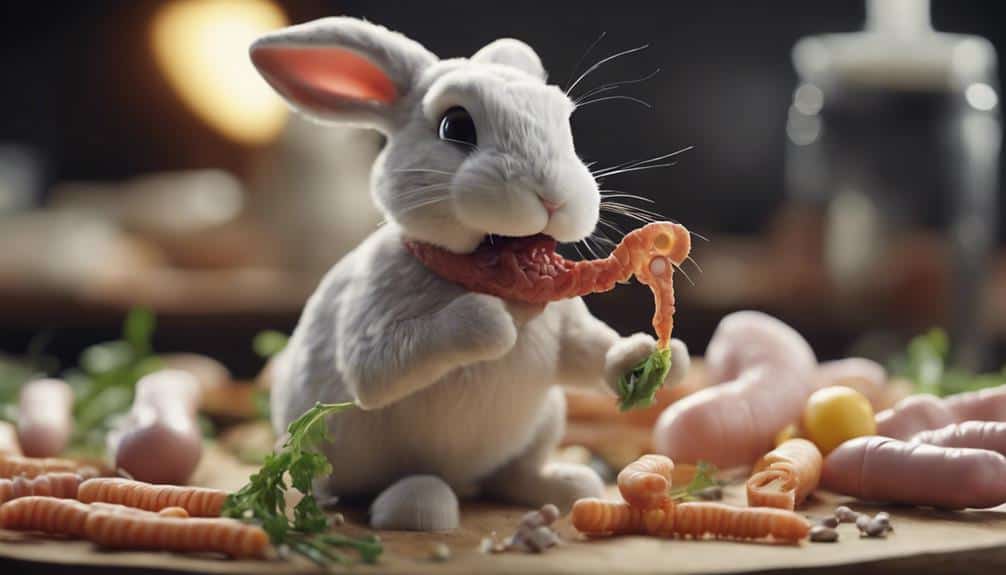
Bunnies have a pretty cool way of getting energy from their food. They eat a lot of fibrous plants like grass and hay, which can be tough to break down. But bunnies have a digestive system that's specially built to handle this kind of diet.
The key to their digestive system is how it absorbs nutrients. Bunnies need these nutrients to stay healthy and full of energy. Their gut is like a powerhouse for breaking down all that tough plant material efficiently.
Fiber is a big deal for bunnies. It helps keep their gut moving smoothly and supports the growth of good bacteria in their intestines. These bacteria play a crucial role in a process called hindgut fermentation. This is where they break down the fibrous plant material that the bunny's own enzymes can't fully digest.
Role of Hindgut Fermentation
In rabbits, hindgut fermentation happens in the caecum. Bacteria in the caecum help break down plant material by fermenting it. This process is important because it helps rabbits get nutrients and energy from tough plant fibers like cellulose.
Basically, it's like a special system that turns plant food into energy for the rabbits to use. So, it's a crucial part of how rabbits get the most out of their plant-based diet and stay energized.
Digestion in Cecum
In rabbits, their cecum, a special part of the digestive system, plays a crucial role in getting important nutrients from tough plant material. This process, called hindgut fermentation, happens in the cecum. Here, bacteria break down complex carbs like cellulose found in plants. These bacteria ferment the plant stuff, releasing energy in the form of volatile fatty acids. The rabbit then absorbs this energy and uses it for its body functions.
Thanks to the cecum and hindgut fermentation, rabbits can get energy from food that they wouldn't be able to digest otherwise. This energy is super important for the rabbit's body to work properly and meet its needs. So, the cecum really is a key player in the rabbit's digestion game!
Microbial Fermentation Process
Rabbits have a cool way of getting energy from tough plant stuff. Inside their cecum, which is like a special part of their gut, there are tiny microbes working hard to break down all the fiber in the plants the rabbits eat. These microbes are like little digestion superheroes, especially when it comes to breaking down cellulose, which is really tough to digest.
The bacteria in the cecum are the real MVPs in this process. They take the bits of food that the rabbit couldn't digest and ferment them, which basically means they break them down to release energy. This energy is super important for keeping the rabbit healthy and full of pep. Thanks to this fermentation process, rabbits can get the most out of the fibrous plants they munch on, even though their teeth and regular digestion might struggle with it.
It's pretty amazing how rabbits have evolved to make use of every bit of energy they can from plants that other animals mightn't be able to benefit from. Their hindgut fermentation is like a secret weapon that helps them thrive on a diet that would be tricky for many other creatures.
Energy Extraction Mechanism
Rabbits have a cool way of getting energy from tough plant stuff. They've a big caecum in their digestive system that helps them out. Inside the caecum, special bacteria break down plant parts like cellulose that the rabbit can't digest on its own.
This breakdown releases fatty acids that the rabbit absorbs into its body for energy. Unlike guinea pigs, which digest differently, rabbits use their caecum to get the most out of fibrous plants. This process lets rabbits turn plant material into energy they need to do their daily stuff effectively.
Importance of High-Fiber Diet
When you think about why a high-fiber diet is crucial for bunnies, it all comes down to how fiber helps with digestion and gives them essential nutrients.
Fiber plays a key role in keeping their gut healthy by helping with digestion and making sure they absorb nutrients efficiently.
Bunnies get their energy from the fiber found in foods like hay and grass, which are really important for keeping their digestion in top shape and overall health in check.
Fiber for Digestion
Rabbits need high-fiber foods to keep their digestive system healthy and help them get the most out of their plant-based meals. Fiber is super important for rabbits because it helps break down their food in the gut, making digestion easier. When fiber ferments in the caecum, it gives rabbits important nutrients and energy they need to stay healthy.
If rabbits don't get enough fiber in their diet, they can have tummy troubles and not get all the nutrients they need. That's why it's essential to give them lots of hay and grass, which are rich in fiber. By feeding them a fiber-rich diet, we can make sure they stay happy and their digestive system works as it should.
Gut Health Benefits
To keep your rabbit's gut healthy, it's important to give them lots of fiber in their diet. Fresh hay is a great source of fiber and helps good bacteria grow in their gut, which is essential for proper digestion.
Fiber also helps with fermentation in their digestive system, giving them the energy they need for their daily activities. By feeding them a mix of fresh, high-fiber foods like leafy greens and veggies, you can make sure your bunny's gut stays in top shape.
This healthy gut environment makes it easier for your rabbit to absorb nutrients and produce the energy they need to stay happy and active.
Energy From Fiber
Bunnies get their main source of energy from the fiber they digest in their tummies. Eating a lot of fiber is really important for keeping bunnies healthy and full of energy. They mainly get their fiber from hay and grass, which gives them the fuel they need to stay active and happy.
When bunnies eat fiber, it goes through a fermentation process in their big intestines. This is where the energy from the fiber is released and used by the bunnies to stay strong and bouncy. To make sure they've enough energy, bunnies need to munch on fiber-rich foods all day long.
Having a diet high in fiber is super important for bunnies to keep feeling good, as it helps their digestion and keeps their energy levels up.
Nutrient Extraction Process
When rabbits eat plants, their digestive system can't fully break down the tough cellulose in them. But luckily, rabbits have special gut bacteria in their large intestine that can help out. These bacteria have enzymes that can break down the cellulose into simpler molecules through fermentation. This process helps release important nutrients and energy from the plants that rabbits couldn't get to on their own.
Energy Production Mechanism
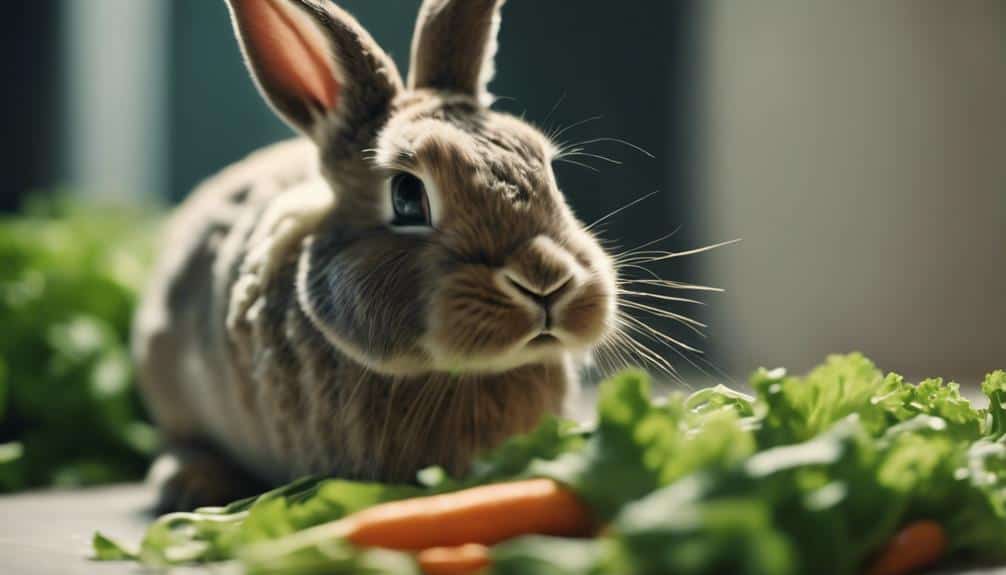
When bunnies eat plants, their digestive system breaks down the complex carbs into simple sugars to make energy.
After absorbing these sugars, they go through cellular respiration to turn them into ATP, which is like the fuel for cells.
This process helps bunnies get energy from the tough plant stuff they eat to do their daily stuff.
Digestion for Energy
Rabbits have a cool way of getting energy from their plant-based diet. They've special gut bacteria in their large intestine that help them out. These bacteria help with fermenting the food in their caecum, which is like a big pouch in their digestive system. This fermentation process is super important for giving bunnies the energy they need.
During fermentation, the bacteria break down tough stuff like cellulose and other plant materials that rabbits can't digest on their own. By breaking these things down, the bacteria make simpler molecules that the rabbit's body can use for energy. It's like a teamwork between the bacteria and the rabbit's body to get the job done.
But wait, there's more! Rabbits also make something called caecotrophs, which are soft poop pellets full of nutrients. These pellets are made during fermentation and are like a super nutritious snack for the rabbits. They actually eat these caecotrophs to get even more energy and essential nutrients from the fermentation process. It's a pretty neat system that helps bunnies stay energized and healthy.
Cellular Respiration Process
Bunnies use a process called cellular respiration to turn nutrients into ATP, which is like the fuel that powers their cells. Here's what you need to know about how this works:
When bunnies eat, the glucose from their food gets broken down with oxygen to make ATP through a bunch of chemical reactions.
The ATP made is super important for things like moving muscles, sending signals in nerves, and keeping all the other life processes going.
All this action happens in the mitochondria of bunny cells. That's where glucose gets turned into ATP efficiently to give them the energy they need.
To keep this whole system running smoothly, make sure your bunny eats a balanced diet and gets any dental issues taken care of quickly to avoid any problems with energy production.
Hay as Primary Energy Source
Bunnies rely on hay for their main source of energy because it's packed with fiber that helps them digest food and absorb nutrients effectively. Fiber, a type of carbohydrate found in hay, plays a crucial role in how bunnies process their food. When bunnies eat hay, the fiber goes through a fermentation process in their cecum, a special part of their digestive system. This process breaks down the fiber into simpler compounds, releasing energy that the bunny's body can use.
Chewing on hay isn't just a casual snack for bunnies – it's actually a must-do activity. This constant chewing helps wear down their teeth, which grow continuously. Keeping their teeth in check prevents dental problems that could make it hard for them to munch on hay properly. So, having a steady supply of hay is super important for keeping bunnies energized and healthy, making sure their digestive system works like a charm.
Caecum Fermentation Process
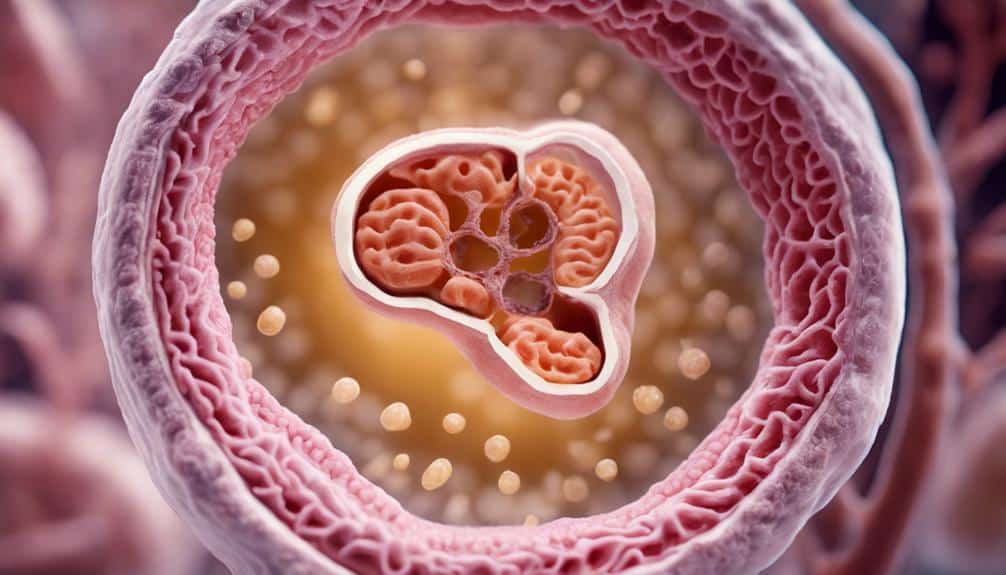
Rabbits have a special chamber called the caecum in their digestive system that helps them break down tough plant materials like cellulose. This process is crucial for them to get energy from their high-fiber diet effectively.
Here are three important things to know about how the caecum works:
- Where the Magic Happens: The caecum is like the fermentation HQ for rabbits. Inside, bacteria work hard to break down stuff like cellulose that the rabbit's stomach can't handle on its own.
- Special Poop Alert: When fermentation happens in the caecum, rabbits make special poop called caecotrophs. These soft, nutrient-rich pellets are eaten again by the rabbit to get even more nutrients and energy from their food.
- Getting the Good Stuff: Thanks to the caecum's fermentation party, rabbits can grab important nutrients like fatty acids, vitamins, and proteins from their high-fiber diet. This boosts their health and keeps them bouncing with vitality!
Fiber's Impact on Energy Extraction
Fiber plays a big role in helping rabbits get energy from their food. It helps the rabbits and their gut bacteria work together to turn tough plant material into energy that the rabbits need.
Rabbits need a diet that's high in fiber to help their hindgut, where special bacteria break down plants. This breakdown process happens mostly in the caecum, allowing rabbits to get important nutrients and energy from fibrous foods.
When rabbits munch on hay and grass with lots of fiber, they help their digestion work well. This means they can get the most energy possible to keep up with their active lifestyle and metabolic needs.
The partnership between rabbits and their gut bacteria is crucial for turning tough plant material into usable energy sources. Having a balanced diet rich in fiber is key for these little mammals.
Sustaining Daily Activities

Bunnies stay active and healthy by getting energy from fibrous plant material in their large intestine. Let's break it down in simple terms:
First off, bunnies munch on high-fiber foods like hay to keep their digestion in top shape. This fiber gets fermented in their large intestine, which is key for making energy.
Then, there's this interesting thing bunnies do – they eat special feces called caecotrophs. These pellets are packed with nutrients that didn't get fully absorbed the first time around. By chowing down on these pellets, bunnies can get all the good stuff they missed out on, boosting their energy levels.
Lastly, bunnies have some helpful gut bacteria that aid in digesting plant material efficiently. These little helpers break down tough plant stuff into energy that bunnies can use. So, bunnies and their gut buddies work together to get the most out of their food.
Well-Being Maintenance
Taking care of bunnies is all about making sure they can get the most out of their food with the help of gut bacteria. Bunnies have a special way of digesting their food – they ferment plant material in their large intestine, which helps break down tough stuff like cellulose and get those important nutrients out. To keep them going strong, it's key to feed them lots of high-fiber foods like fresh leafy greens, grass hay, and rabbit pellets. These foods give them the fiber they need for good digestion in a special organ called the caecum.
The caecum is where all the magic happens – the fermentation process in there gives bunnies the energy they need for hopping around and staying healthy. Bunnies also have a neat habit called cecotrophy, where they eat soft, half-digested pellets straight from their back end. It might sound gross, but it's actually super important because those pellets are packed with vitamins and minerals that keep them energized and feeling good.
Frequently Asked Questions
How Does Rabbits Get Energy?
Rabbits need energy to hop around and do rabbit things. They get this energy from their special digestive system. Basically, their metabolism breaks down plant stuff with the help of gut bacteria to make energy. By eating a lot of fiber and re-eating their poop (caecotrophs), they make sure they have enough energy to keep going and doing their rabbit stuff at their best.
What Is the Energy Requirement for a Rabbit?
Your rabbit needs a certain amount of energy to stay healthy, and this can vary based on factors like how big they are, how much they move around, and how fast their metabolism works. To meet their energy needs, they should eat a diet that's high in fiber. This fiber gets broken down by bacteria in their large intestine, which then provides the energy they need to stay active and healthy.
Can Bunnies Be Energetic?
If you want your bunny to stay lively and energetic, make sure they get regular exercise, playtime, and mental stimulation. Keep them engaged in activities that keep them moving and mentally sharp. Creating an environment that challenges and entertains them will help keep their energy levels up.
What Makes Rabbits Excited?
Rabbits get excited by playing around, munching on their favorite foods, and hanging out with other bunnies. They love exploring new places, playing with toys, and making friends. All these things keep them happy and full of energy.
Conclusion
So, now you know how bunnies get their energy. They basically munch on a lot of fiber-rich food, which helps them power through their day. The key here is their hindgut fermentation process in the digestive system. This process helps them break down all that fiber and extract the nutrients they need to stay active.
The caecum, a part of their digestive system, is like their secret energy factory. It plays a crucial role in the fermentation process, converting all that fiber into usable energy. So, by having a well-balanced diet and taking good care of themselves, bunnies can keep their energy levels up and stay on the move.
Just remember, a happy bunny is a healthy bunny! So, make sure they've the right food and care they need to keep bouncing around happily.

